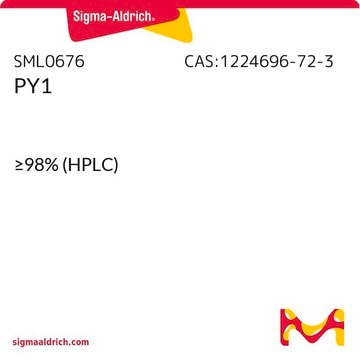53271
Mito Red
suitable for fluorescence, ≥70% (HPLC)
Synonym(s):
3,6-Bis(diethylamino)-9-[2-(4-methylcoumarin-7-yloxycarbonyl)phenyl]xanthylium chloride, Rhodamine B 4-methylumbelliferyl ester chloride
About This Item
Recommended Products
Assay
≥70% (HPLC)
form
solid
fluorescence
λex 569 nm; λem 594 nm in DMSO
suitability
suitable for fluorescence
storage temp.
2-8°C
SMILES string
[Cl-].CCN(CC)c1ccc2c(-c3ccccc3C(=O)Oc4ccc5C(C)=CC(=O)Oc5c4)c6ccc(cc6[o+]c2c1)N(CC)CC
InChI
1S/C38H37N2O5.ClH/c1-6-39(7-2)25-14-17-31-33(21-25)44-34-22-26(40(8-3)9-4)15-18-32(34)37(31)29-12-10-11-13-30(29)38(42)43-27-16-19-28-24(5)20-36(41)45-35(28)23-27;/h10-23H,6-9H2,1-5H3;1H/q+1;/p-1
InChI key
XCVSDCPWJRHMSZ-UHFFFAOYSA-M
General description
Application
Storage Class Code
11 - Combustible Solids
WGK
WGK 3
Flash Point(F)
Not applicable
Flash Point(C)
Not applicable
Personal Protective Equipment
Certificates of Analysis (COA)
Search for Certificates of Analysis (COA) by entering the products Lot/Batch Number. Lot and Batch Numbers can be found on a product’s label following the words ‘Lot’ or ‘Batch’.
Already Own This Product?
Find documentation for the products that you have recently purchased in the Document Library.
Customers Also Viewed
Articles
Nitric oxide (NO) as a signal transporter in neurons, endothelial cells and in the immune system.
Our team of scientists has experience in all areas of research including Life Science, Material Science, Chemical Synthesis, Chromatography, Analytical and many others.
Contact Technical Service









